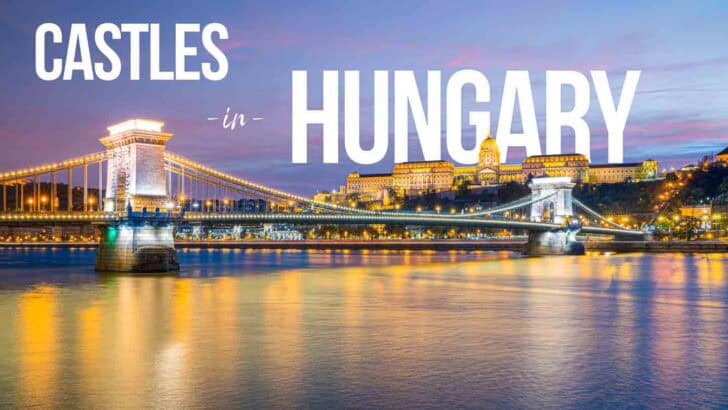This central European gem has many stunning pieces of architecture but none are quite as grand as the castles in Hungary. With its central position, Hungary was often under siege which led to many castles being built for protection throughout the centuries.
Today the Hungarian castles stand as a reminder of the past and to honor the country’s long heritage. Many of the castles were home to royal families, great leaders, and served to protect the people.
Here’s a short list of the best castles in Hungary open to visit on your next trip!
Hungarian Castles FAQ
- How many castles are in Hungary? There are 103 Castles in the Country of Hungary many of which are open to the public.
- What is the oldest castle in Hungary? The Buda Castle is the oldest castle in Hungary dating back to 1265. Since that time it has been added on to, renovated, and damaged by war many times.
- Why does Hungary have so many castles? In Midevil times castles were built in Hungary primarily for protection. In the 1700s and 1800s some castles and palaces we renovated by royals and elites to be turned into private residences.
- What castles are in Budapest? The city of Budapest has two castles, Buda Castles and Vajdahunyad Castle.
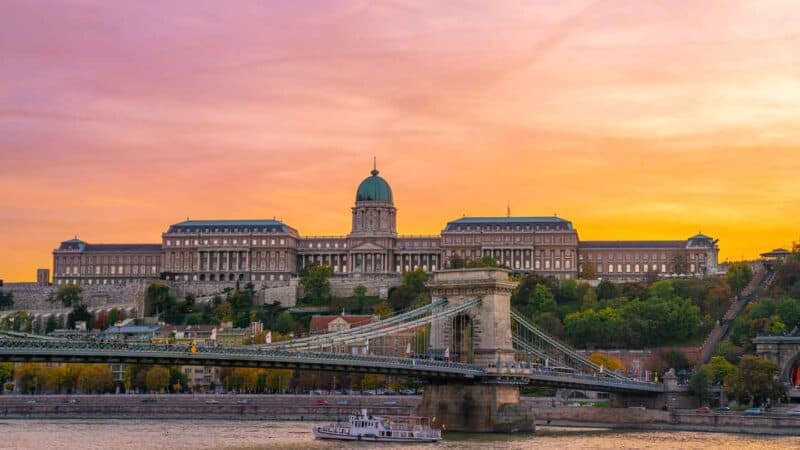



1. Buda Castle
Situated on top of Castle Hill in Budapest, Buda Castle is a stunning Baroque palace overlooking the Danube River. The original castle was built in 1265 by King Béla IV of Hungary to defend against the invading Mongols and Tartars. It was altered by residing Kings over the next few centuries until it was severely damaged in the 1500s and 1600s by different army forces. The current structure that you see today was built in 1769.
Although there are over 200 rooms in the castle, many of them were destroyed during WWII. The castle courts, fishermen’s bastion, and the historical square are still open to visitors. There are also numerous sites located within the castle walls, including the Hungarian National Gallery, the Budapest Castle Museum, and the Budapest Castle Library.
You can reach Buda Castle by walking uphill (15-minutes) towards the Castle District, or by taking the funicular. It’s also worth spending time walking around the Castle District itself. The winding cobblestone streets and beautifully preserved Baroque houses are packed with charm. If you only see one of the beautiful castles in Hungary, it should be this one.
- Hours: Courtyards open 24/7, walking tours start at 2 pm daily
- Ticket price: 11 EUR (adult), 5.5 EUR (reduced)
- Address: Budapest, Szent György tér 2, 1014
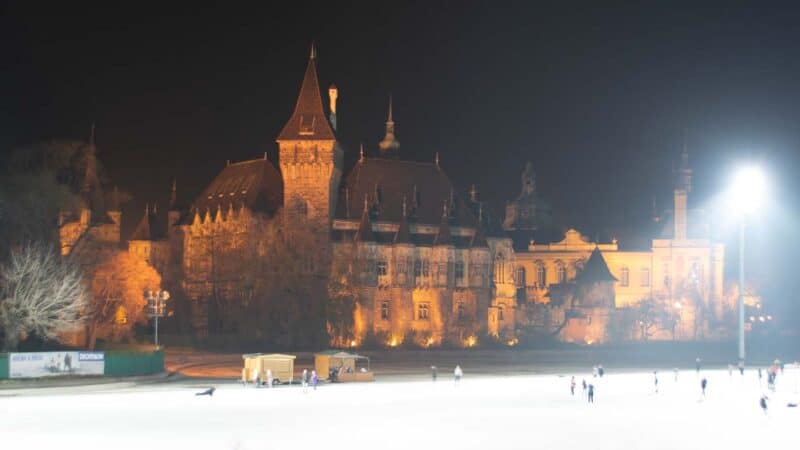


2. Vajdahunyad Castle Budapest
The Vajdahunyad Castle Budapest was built in 1896 as a monument to commemorate the 1,000 anniversary of Hungary since the Hungarian Conquest of the Carpathian Basin. The building has elaborate Romanesque, Gothic, Baroque, and Renaissance styles. It was modeled after several other castles, such as the Kingdom of Hungary and the Hunyard Castle in Romania. These different styles showcase the architectural evolution of Hungary over the last few centuries.
Nowadays, the courtyards of Vajdahunyad Castle Budapest are used for festivals, concerts, and exhibitions. One of the castle’s biggest highlights is the statue of “Anonymus,” who many believe to be King Béla III. The castle contains the Hungarian Agricultural Museum, the biggest agricultural museum in Europe. Visiting the museum is the only way to see the interior of the building.
- Hours: Tuesday – Sunday: 10am – 5pm
- Ticket price: Courtyards are free, Hungarian Agricultural Museum tickets are 1,600 HUF (adult), 800 HUF (reduced)
- Address: Budapest, Vajdahunyad stny., 1146 Hungary
Related: Museums in Budapest
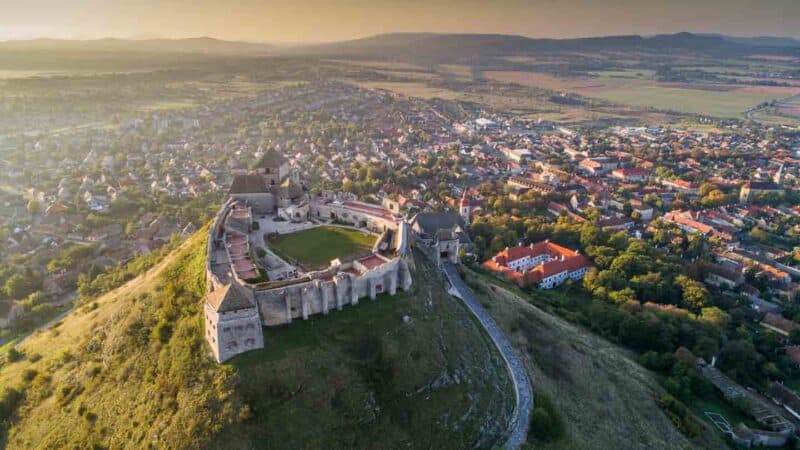



3. Sümeg Castle
The imposing Sümeg Castle is perched atop Castle Hill overlooking the small village of Sümeg. This 13th-century castle was constructed by Bela IV, although it was greatly expanded over the next few centuries and was even fortified by the Turks. In 1713, the entire castle was lit on fire by Austrian occupants in Hungary, destroying large sections. The current building was restored in the 1900s.
Inside the building, you’ll find a torture chamber, a medieval kitchen, a chapel, stables, and even an on-site coach museum. The defense draw bridge, cannons, and cisterns remain from the castle’s fortress days.
- Hours: Daily 9 am – 7 pm
- Ticket price: 2,000 HUF (adults) 800 HUF (reduced)
- Address: Sümeg, Vároldal u. 5, 8330
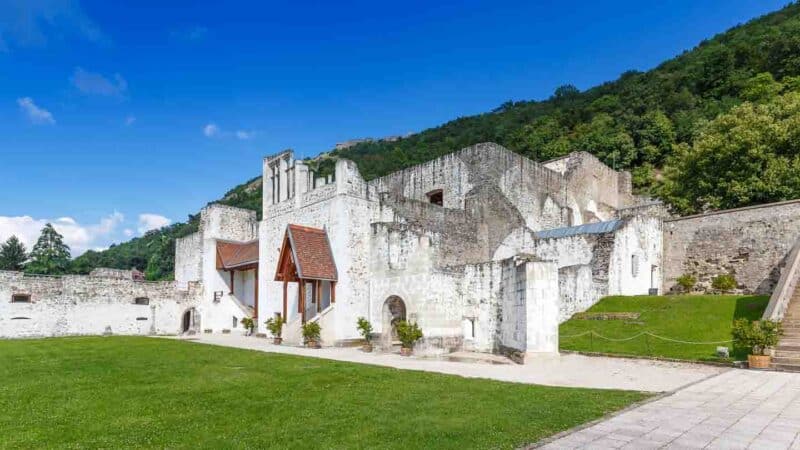



4. Royal Palace of Visegrád
The original site of the Royal Palace of Visegrád was built in 1325 by King Charles I of Hungary. When the throne was passed to King Charles’ son, King Louis, major construction was done to the palace. At first, he expanded different rooms of the palace, but then completely dismantled the entire building to make room for a new structure. The new palace was used as the primary residence of the Hungarian Kings until the early 1400s.
Unfortunately, the castle was destroyed in 1544 by the Ottoman Turks. It was left to crumble and was completely buried just a few centuries later. A large portion of the palace has been excavated and restored, although only 20 of the original 350 rooms are open to the public.
During your visit, you’ll see the royal bed-chamber, a kitchen, and the St. George’s chapel. Sitting at the center of the palace in the Court of Honour is the red marble Hercules Fountain, which is actually a replica of the original fountain that lives in the Matthias Corvinus Museum.
- Hours: Tuesday – Sunday: 9am – 5pm
- Ticket price: 1,400 HUF (adults), 700 HUF (reduced)
- Address: Visegrád, Várhegy, 2025
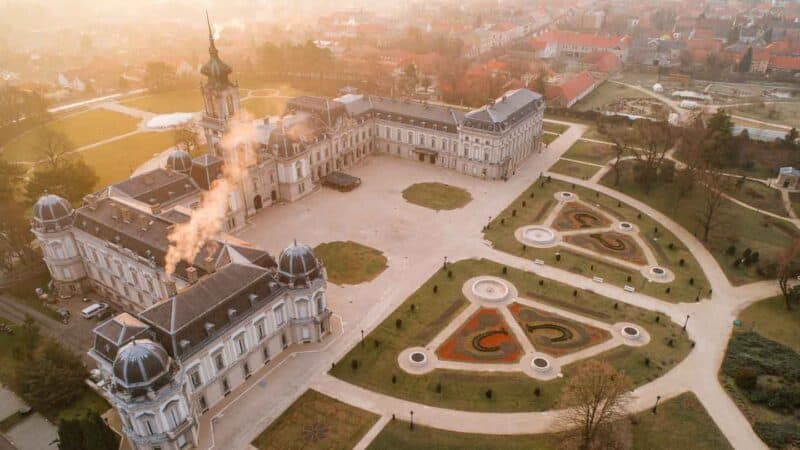



5. Festetics Palace
The spectacular Festetics Palace was originally built to be the residence for the affluent Festetics Family, who immigrated from Croatia during the 17th century. Although Kristóf Festetics, the family’s patriarch, started construction in 1745, he didn’t survive to see the outcome. It took three different architects more than 140 years to complete the palace, which is now the third-largest palace in the country.
The sheer size of the Festetics Palace makes it one of the best castles to see in Hungary. There are two stories, 34 ornately-decorated rooms, and even an on-site library. Since it was not damaged during WWII, much of the castle remains in its original condition. You can also see many artifacts, books, and furniture used in the castle during the late 1800s.
After Kristóf’s death, the palace was handed down to the rest of his family. Kristóf’s great-great-great-great-grandson, Prince Tassilo II, was the last family member to live in Festetics Palace. It’s now a museum with several exhibits showcasing the aristocratic lifestyle in Hungary during the 19th century.
- Hours: Daily 9am – 6pm
- Ticket price: 2,300 HUF
- Address: Keszthely, Kastély u. 1, 8360
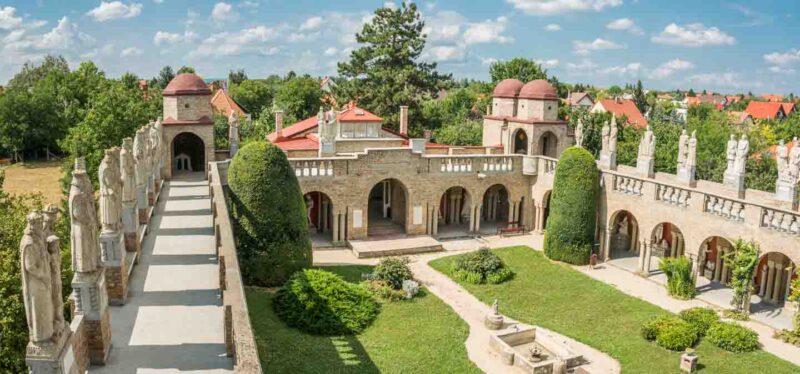



6. Bory Castle
Rory Castle is a fascinating work of art and a prime example of Hungarian architecture. In 1912, Jenõ Bory bought a one-acre property in Székesfehérvár and decided to build a palace that would become his summer residence. Bory himself planned, coordinated, and built the palace by hand in just 40 years, with the help of a few other workers.
Once it was finished, the palace was almost 1,000 feet high. The massive structure includes seven towers, 30 different rooms, a dungeon, and manicured gardens. Bory then continued to personally decorate the interior of the castle. There are several hundred statues dotted around the estate, and even more paintings, mosaics, and antiques. Many people believe that the paintings of Hungarian history in the Court of the Hundred Columns are the most striking things to see in the palace.
The tree-lined gardens surrounding the castle are almost as beautiful as the building itself. The front garden contains many of Bory’s concrete statues and fountains. The rose garden includes a more intimate set of art. Not only will you find a white marble portrait of Bory’s wife, but you’ll also see several busts of his friends and fellow artists. Finally, you have the Elephant Garden, which sits under the archway on the second terrace. Here, you’ll see a peculiar statue of a giant elephant standing on a ball.
- Hours: Daily 9am – 5pm
- Ticket price: 1,800 HUF (adults) 900 (reduced)
- Address: Székesfehérvár, Máriavölgy 54, 8000
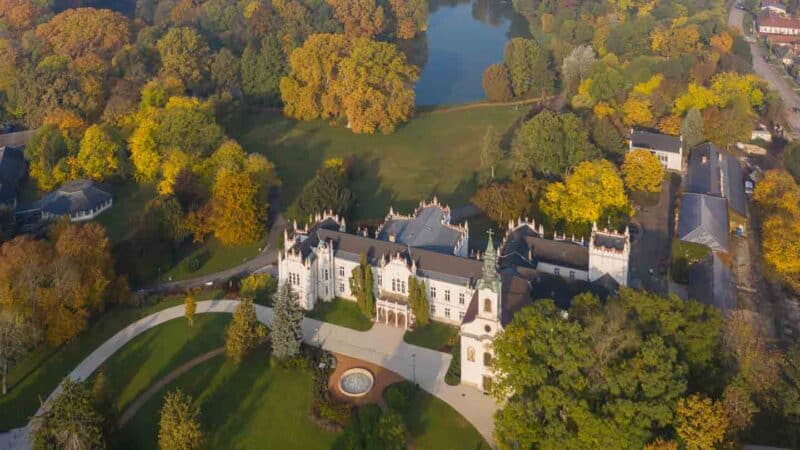



7. Brunszvik Castle Martonvásár
Built in 1785, the Brunszvik Castle is a romantic, fairy-tale-like palace surrounded by lush gardens and sparkling lakes. It was restored 100 years later and designed in a neo-Gothic style.
Even if you aren’t familiar with the Brunszvik Castle, you might know one of its most famous guests: Ludwig van Beethoven was friends with many different members of the Bruszvik family. For this reason, Beethoven visited the castle several times throughout his life and even wrote his iconic composition Fur Elise while staying on the property.
As one of Martonvásár’s most popular tourist attractions, the Brunszvik Castle is a rare glimpse into this famed composer’s life. It’s also home to the country’s only Beethoven Museum. Here, you’ll learn more about Beethoven’s connection to the Bruszvik family, and see a few of his personal items that were used in the castle. One of the more bizarre artifacts in the museum is a lock of his hair, which is sealed in a glass frame.
Besides a visit to the Beethoven Museum, it’s worth walking around the castle grounds. This tree-lined park has a little lake with a small island in the middle, which can be accessed by an arched wooden footbridge.
- Hours: Tuesday – Friday: 10 am – 12pm, 2pm – 4pm, Saturday and Sunday: 10 am – 12pm, 2pm – 5pm
- Ticket price: 1,800 HUF (adults) 900 (reduced)
- Address: Martonvásár, Brunszvik u. 2, 2462
8. Esterházy Castle Pápa
The historic Esterházy Castle was built between 1773 and 1784 by the Esterházy family. This aristocratic family owned several large properties and was one of the most influential families during the Astro-Hungarian Empire. The castle sits on the site of what was once a medieval fortress. Its current Baroque structure was even built using some of the fortress’ old stones. Around the castle, you’ll find acres of lush green gardens.
Unlike other castles in Hungary, Esterházy Castle offers live guided tours with costumed actors. From the second you walk through the door, you’ll be transported back to the 18th-century as you are greeted by nobles and aristocrats. Throughout the tour, you’ll gain insight into their lifestyle, with traditional live dances, songs, and stories from this period.
Esterházy Castle also hosts a variety of fun and engaging events. You can take pictures wearing your very own Baroque costume, or sign up for one of their chocolate bonbon making classes. There’s even an on-site marionette theater, as well as a permanent art exhibition devoted to the works of Antal Nemcsics.
- Hours: Opening and tour hours vary by season
- Ticket price: 2,100 HUF (adults) 1,200 (reduced)
- Address: Pápa, Fő tér 1, 8500
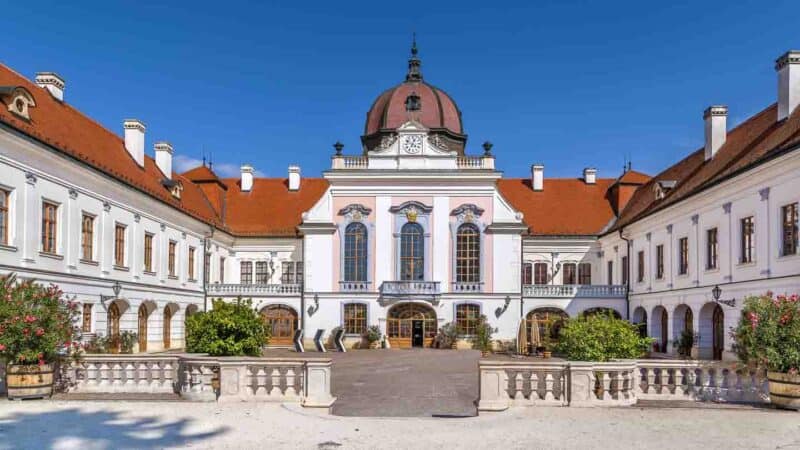



9. Royal Palace of Gödöllő
Located in the central city of Gödöllő, The Royal Palace of Gödöllő is known for being the favorite retreat of Emperor Franz Joseph and Queen Elizabeth (more commonly known as Sisi).
It was built in the early 1700s and saw different restorations and additions during its lifetime. After Queen Elizabeth’s death, the castle was handed over to the Hungarian admiral Regent Miklós Horthy, before being completely restored in the 1980s.
Now, the palace is a massive double U-shaped structure with eight wings, a church, a theater, and even a riding hall, which are all open to visitors. It’s also worth visiting the King’s Hall Pavilion, located a few feet from the property. This pavilion is the last remaining building from the original structure and contains 54 oil paintings depicting Hungarian leaders, Kings, and conquests.
Many of Queen Elizabeth’s rooms were also preserved, including her royal suite, dressing room, and writing room. The rooms have been restored and decorated to reflect the style of when she lived there. The garden and veranda surrounding the castle were also built to commemorate her life.
- Hours: Daily: 10am – 6pm
- Ticket price: 3,200 HUF (adults), 1,800 HUF (reduced)
- Address: Gödöllő, Grassalkovich-kastély 5852, 2100
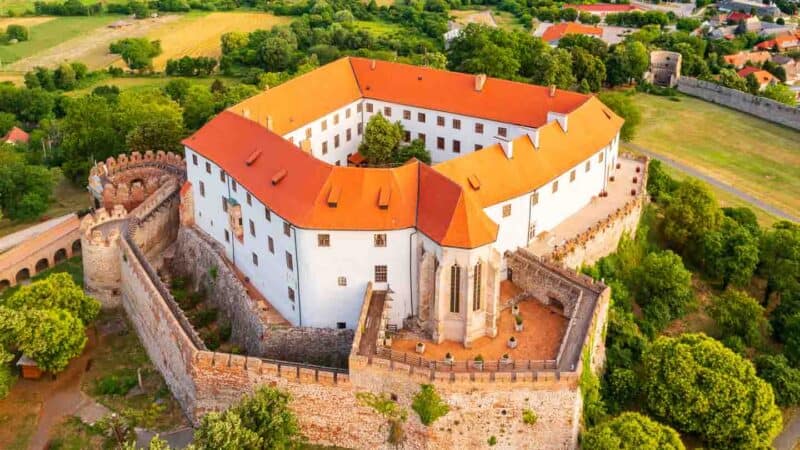



10. Siklos Castle
Siklos Castle has a lengthy history with Hungary’s most noble families. Since it was built in the mid-1200s, it has been owned by the Soklyosi family, the Gara family, and the Batthyany-Strattmann family, to name a few. It was sold to the state in 1936 and eventually used as a prison during WWII.
Visitors can now see the renovated castle in its full glory by exploring one of the many museums on the estate. There’s the medieval military exhibition, the castle history exhibition, a WWI and WWII exhibition, and even a winemaking exhibition. You can also tour the torture chambers, the castle chapel, and several other rooms that remain from the castle’s golden years during the 15th century.
- Hours: Daily: 9:30am – 6pm
- Ticket price: 1,900 HUF (adults) 700 – 1,000 (reduced)
- Address: Siklós, Vajda János tér 8, 7800
